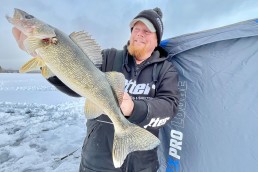Cracking Walleyes on First Ice
SHARE THIS POST
Brian Brosdahl focuses on small, shallow lakes to begin his ice walleye season.
It seems there is no such thing as a quiet lake during the summer months, even in northern areas. When freezing temperatures and snow move in, things change; busy lakes grow quiet during the ice freeze-up. But the fall bite doesn’t end at first ice. The walleyes’ instinct is to chew even more. This is where ice fishing really takes off!
Start small and weedy
I like to start with small, shallow walleye lakes because they freeze first, and I don’t have to worry about heaves, breakaway ice or floes every time the wind blows.
There are thousands of shallow lakes to fish in Minnesota, Wisconsin and the Dakotas that have great walleye populations. Many are off the radar as walleye-seekers head to Upper Red Lake and Lake of the Woods—with great reason. However, “small lake” doesn’t mean tiny. Numerous 300- to 3,000-acre lakes are walleye producers.
Study maps to find access points that are close to lake features that typically hold walleyes. Expansive weed flats always have active walleyes cruising through. Find a fairly steep break line or inside turn that comes close to shore. I have caught walleyes over 30 inches long only 50 yards from shore.
But every lake is different. Some lakes will require you to put more work into walking out to the edge of the weed bed. The key thing to remember is that walleyes love weeds. They are creatures of edges, and transitions from rock to sand, in places where food is abundant.
Tackle ‘em with spoons
Using spoons is one of the most productive ways to catch walleyes during first ice. I have tried hundreds of different spoons and I believe it is all about the action and color. Getting the right combination required a lot of spoon dunking in my life.
Tip it with a minnow head and jig it. Make a quick, one- to two-foot sweep with the rod tip to get their attention. Then, impart short buggy whips to get the rattles working. Pause for a second or two and start up again. Using my Humminbird MEGA Live and Aqua-Vu 722 in concert, I have watched walleyes race over from 20-plus feet away to crush it. This really gets your heart racing!
Tip: Match the hatch. Try multiple colors, as every lake has a different preference. But you can’t go wrong with perch patterns, red glow or metallics on any body of water.
Are you enjoying this post?
You can be among the first to get the latest info on where to go, what to use and how to use it!
The spoon rod
When jigging a spoon, don’t use a rod that is too soft. You want the spoon to move when you jig it. I have seen people jigging with noodle rods; they jig, but the rod tip bends and the spoon doesn’t move much. Ice fishing rod actions are very important, just as in open-water fishing.
- Medium-light action is good for 1/16- to 1/8-ounce spoons
- Medium is good for 1/8- to 1/4-ounce
- Medium-heavy is best for 3/8-ounce and up
I use a 28- to 36-inch St. Croix Skandic when I’m outside roving on the ice. I use a 24- to 28-incher when I am in my portable fish house, and a 28- to 32-inch rod in my Otter Vortex Pro. I want to be able to jig and set the hook without hitting the ceiling. The lightness in the rod helps the jigging cadence. I also want backbone for fighting big walleyes and for piercing their boney mouths, and I like their flexible tip for walleye tantrums at the bottom of the ice hole.
Tip: Smart storage is worth it! I used to have a bad habit of rods bouncing around in my buckets, but now I safely store my St. Croix rods in an Otter Pro-Tech rod case. Lesson learned!
Hook, line and sinker
Many northern Minnesota lakes have cleared due to invasive species. While braid works in bog-stained lakes like the murky waters of Lake of the Woods, it does wick water, so you end up with frozen rod eyes when fishing outside a shelter. If you’re inside, it works fine in a lighter diameter with a 3- to 4-foot fluorocarbon leader.
Don’t be afraid to try light line. Just set your drag accordingly and use abrasive-resistant fluorocarbon. For the most part, I use 3- to 7-pound, clear Sunline Fluorocarbon Ice; 6- to 7-pound is for fishing spoons. Three- to 5-pound is for live bait rigs.
I use Gamakatsu Octopus-style or Finesse Wide Gap #4 or bigger hook when using larger minnows. I also keep a multi-pack of Gamakatsu fluorescent or metallic colors and add split shot sinkers to sink the minnow.
For more tips from the pros who know, check out the winter issues of MidWest Outdoors, available by subscribing on our website.
MWO
SHARE THIS POST
You may also like...
Nothing found.
Did you enjoy this post?
You can be among the first to get the latest info on where to go, what to use and how to use it!
Brian 'Bro' Brosdahl
Outdoor communicator Brian “Bro” Brosdahl lives in northern Minnesota. He is a walleye guide in the Cass Lake, Leech Lake and Lake Winnibigoshish areas. He is sponsored by Northland Fishing Tackle, Frabill/Plano, Aqua-Vu, Humminbird/Minn Kota, St. Croix Rods, Ranger Boats, and Evinrude. Guide inquiries: brosguideservice.com. Follow on social media.
